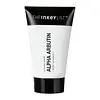What's inside
What's inside
 Key Ingredients
Key Ingredients

 Benefits
Benefits

 Concerns
Concerns

No concerns
 Ingredients Side-by-side
Ingredients Side-by-side

Water
Skin ConditioningButylene Glycol
HumectantPropanediol
SolventGlycerin
HumectantAlpha-Arbutin
AntioxidantDicaprylyl Carbonate
EmollientCaprylic/Capric Triglyceride
MaskingPhenoxyethanol
PreservativeHydroxyethyl Acrylate/Sodium Acryloyldimethyl Taurate Copolymer
Emulsion StabilisingCaprylyl Glycol
EmollientSqualane
EmollientPhospholipids
Skin ConditioningGlycine Soja Oil
EmollientCarbomer
Emulsion StabilisingPolysorbate 60
EmulsifyingSodium Phytate
Glycolipids
Skin ConditioningSorbitan Isostearate
EmulsifyingLeuconostoc/Radish Root Ferment Filtrate
AntimicrobialSodium Hydroxide
BufferingGlycine Soja Sterols
EmollientHyaluronic Acid
HumectantTocopherol
AntioxidantWater, Butylene Glycol, Propanediol, Glycerin, Alpha-Arbutin, Dicaprylyl Carbonate, Caprylic/Capric Triglyceride, Phenoxyethanol, Hydroxyethyl Acrylate/Sodium Acryloyldimethyl Taurate Copolymer, Caprylyl Glycol, Squalane, Phospholipids, Glycine Soja Oil, Carbomer, Polysorbate 60, Sodium Phytate, Glycolipids, Sorbitan Isostearate, Leuconostoc/Radish Root Ferment Filtrate, Sodium Hydroxide, Glycine Soja Sterols, Hyaluronic Acid, Tocopherol
 Reviews
Reviews

Ingredients Explained
These ingredients are found in both products.
Ingredients higher up in an ingredient list are typically present in a larger amount.
Alpha-Arbutin is made from hydroquinone and glucose. It may also be derived from the fermentation of soybeans.
This ingredient an antioxidant, meaning it helps protect your skin cells against damage.
Studies show this ingredient helps improve hyperpigmentation and fade discoloration.
Alpha-Arbutin may be used with other ingredients that help with hyperpigmentation. These ingredients include retinol, Vitamin C, niacinamide, and tranexamic acid.
Learn more about Alpha-ArbutinPhenoxyethanol is a preservative that has germicide, antimicrobial, and aromatic properties. Studies show that phenoxyethanol can prevent microbial growth. By itself, it has a scent that is similar to that of a rose.
It's often used in formulations along with Caprylyl Glycol to preserve the shelf life of products.
Propanediol is an all-star ingredient. It softens, hydrates, and smooths the skin.
It’s often used to:
Propanediol is not likely to cause sensitivity and considered safe to use. It is derived from corn or petroleum with a clear color and no scent.
Learn more about Propanediol